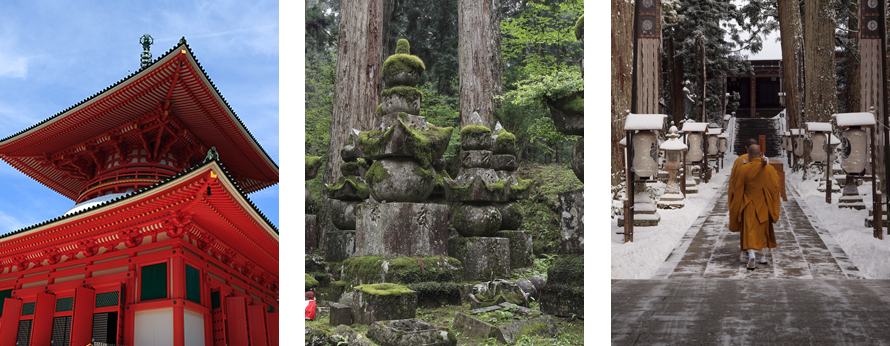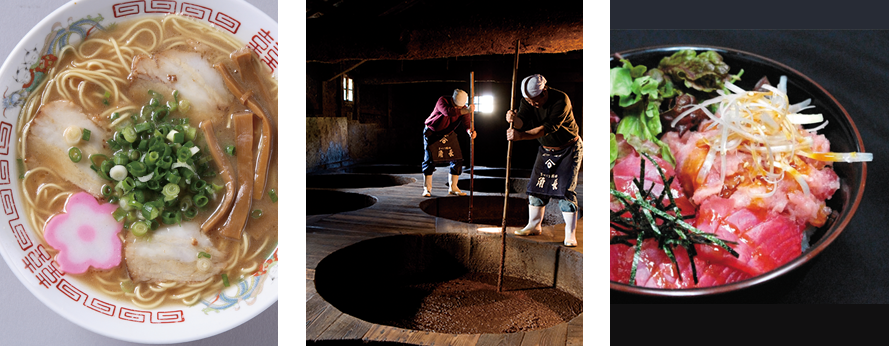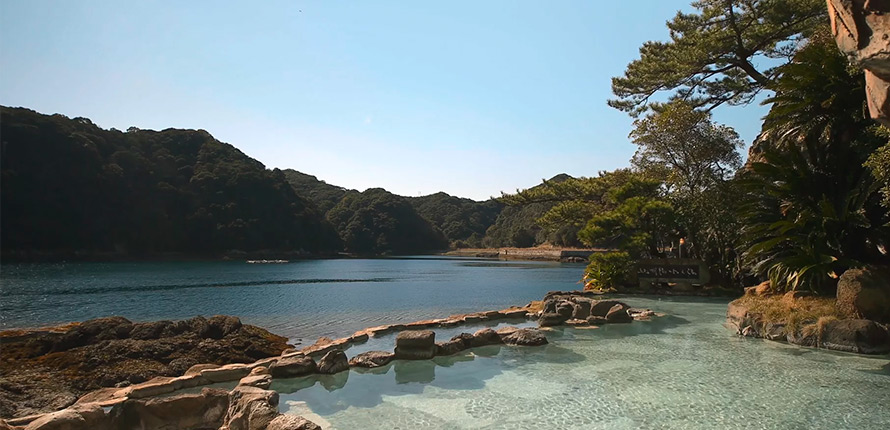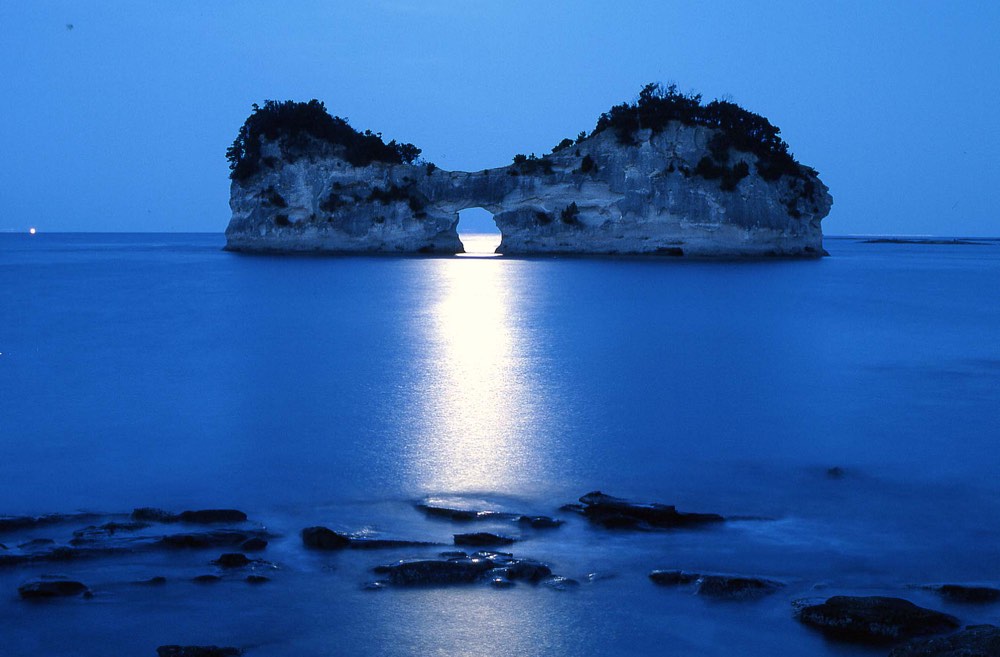

Wakayama
Make it Happen
Spiritually rich and brimming with natural wonders, Wakayama is Japan's best-kept secret. Here are seven ways to get to know this diverse destination.
Take a spiritual adventure
Set among sacred mountains, Wakayama is a treasure trove of ancient temples and shrines. Shrouded in mist and mystery, Koyasan is Wakayama’s spiritual heartland, the birthplace of Shingon Buddhism, and one of three World Heritage sites in the Kii Mountain Range. 117 temples – almost half of which offer accommodation – lay nestled in Koyasan’s forested mountains, giving you a unique opportunity to immerse yourself in this centuries-old heritage site. At Koyasan’s shukubo (temple lodging) – considered among the best overnight experiences in Japan – you can experience the life of a Buddhist monk with meditation, temple services, and vegetarian cuisine.

Tip: You’ll find sample itineraries of the routes here. Book your temple stay in advance by email via the tourist association (eng.shukubo.net).

Embark on an ancient pilgrimage
Walking the Kumano Kodo, a network of pilgrimage routes across wild, waterfall-laced mountains, is a particularly moving way to experience Wakayama's spiritual countryside. The Kumano Kudo is one of only two pilgrimages to which UNESCO granted World Heritage status (the other being the journey across Spain to Santiago de Compostela*) to recognize its millennium-old heritage. The journey connects three spiritually significant shrines: the Kumano Hongu Taisha Grand Shrine, Kumano Hayatama Taisha Grand Shrine, and Kumano Nachi Taisha Grand Shrine. The atmospheric scenery and historic relics make the Kumano Kodo one of the most extraordinary long walks on the planet, with easily navigable routes, hot spring retreats, delicious local food, and rich cultural insight into a relatively unexplored corner of Japan.

Tip: Try the Nakahechi, or Imperial route, which stretches from Tanabe City in the west to Shingu in the east. It's the most popular among the seven major Kumano Kodo trails.
Take a look at sample itineraries of the route here.
*Find out more about the Camino de Santiago here.
Ascend to great heights
Two highlights of the Kumano Kodo pilgrimage are the 1,700-year-old Kumano Nachi Taisha Grand Shrine and the 133-meter-high Nachi Waterfalls – the tallest unbroken water cascade in Japan. Lace up your walking shoes and climb Daimonzaka slope, an ancient cobblestone staircase hugged by towering trees. The climb is well worth the views of the eminent shrine and the iconic three-story Buddhist temple Nachisan Seiganto-ji Temple that sits beside it. The crashing waterfall was venerated by early Japanese settlers and has been the subject of various works of art over the centuries.

Tip: When visiting Wakayama and the mountainous Kii Peninsula, travelers sometimes can’t decide between visiting the mountaintop temple town of Koyasan or exploring the pilgrimage routes and sacred sites of Kumano. With a new daily bus link operating between Wakayama's top spots, visitors won't have to miss out on either. Find out more.
Savor a local feast
Wakayama's fare is distinct and delightful. The self-proclaimed "Kingdom of Fruit" is home to some of the best ramen and freshest seafood in the land. You’ll find that noodle lovers come from far and wide for a steaming bowl of Wakayama ramen. Its unique base, made with a savory pork bone and soy sauce broth, makes Wakayama ramen deliciously addictive. Finish your meal with an arida orange, a thin-rind mandarin orange with a delicate balance of sweet and sour. For a regional specialty, try the rice bowl topped with fatty tuna, usually enjoyed with the flavorful local shoyu (soy-sauce). Enjoy a tipple at Minabe, the largest ume (Japanese apricot) producer in Japan, where you can sample refreshing ume liqueur (umeshu).

Tip: Sample sushi with a twist. Vegetarianism is serious business in Wakayama, and some sushi bars replace raw fish with watermelon, grapes, and peaches. Find out more about Wakayama’s tantalizing local cuisine here.

Cleanse your body and soul
Soaking in an onsen is a quintessential Japanese travel experience – and Wakayama is home to many of the country’s most unique and atmospheric venues. On the shores of the Pacific Ocean in Shirahama, weary travelers and gratified locals have enjoyed Saki-no-yu for over a millennium. Also facing the ocean is Kasuura, with terraced hot spring pools that offer panoramic views of the sea. Nestled within Wakayama’s rugged interior is Sennin-buro in Kawayu, one of Japan’s largest open-air baths, as well as a compelling collection of heritage onsens. The Hongu Onsen-kyo area sits close to the Kumano Hongu Taisha Grand Shrine and is where you can relax in Yunomine, one of Japan’s oldest onsens. Here you’ll find Tsubo-yu, a cozy UNESCO-designated bath with room enough for just one or two people.

Tip: For a clothed onsen experience, soak your feet in hot spring water while you dine at the Ashiyu-Yokocho restaurant in Shirahama. Find out more about Wakayama's relaxing onsens here.
Absorb magnificent views
As you fly over Kansai region and into Nanki-Shirahama Airport, take a look out the window for views of the sweeping beaches below. Shirahama is Japanese for "white beach" – and as you descend into town, you’ll begin to see why it carries the name. Sandwiched between forest green mountains and the deep blue ocean are broad strips of snow-white beaches that wrap this corner of Japan.

Tip: Don’t miss Engetsuto Island – an uninhabited rock isle with a sea cave in the middle – and Sandanbeki Rock Cliff – with its 60-meter-high, 2-kilometer-long rock walls. You can find sample route itineraries here. If you are looking for an extra special premium accommodation experience, try a night or two at Nanki-Shirahama Marriott Hotel, Infinito Hotel & Spa Nanki-Shirahama, Shirahama Key Terrace Hotel Seamore, or Kisyu Shirahama Onsen Musashi.
Immerse yourself in the landscapes on two wheels
For an unhurried way to experience dramatic natural beauty, consider a trip on two wheels. From majestic mountains to curvy coastlines, Wakayama offers almost 800km of diverse route options. And with few junctions and minimal traffic, Wakayama’s cycling trails can suit any type of cyclist. If you’re a seasoned rider, you can satisfy your need for speed and challenge the strength of your legs on the 94km-long route along the southernmost tip of Honshu Island and Nanki Kumano Geopark. If you’re a casual rider, try the 13km-long route that circles Shirahama Beach and hot springs. For more routes and information, click here.

